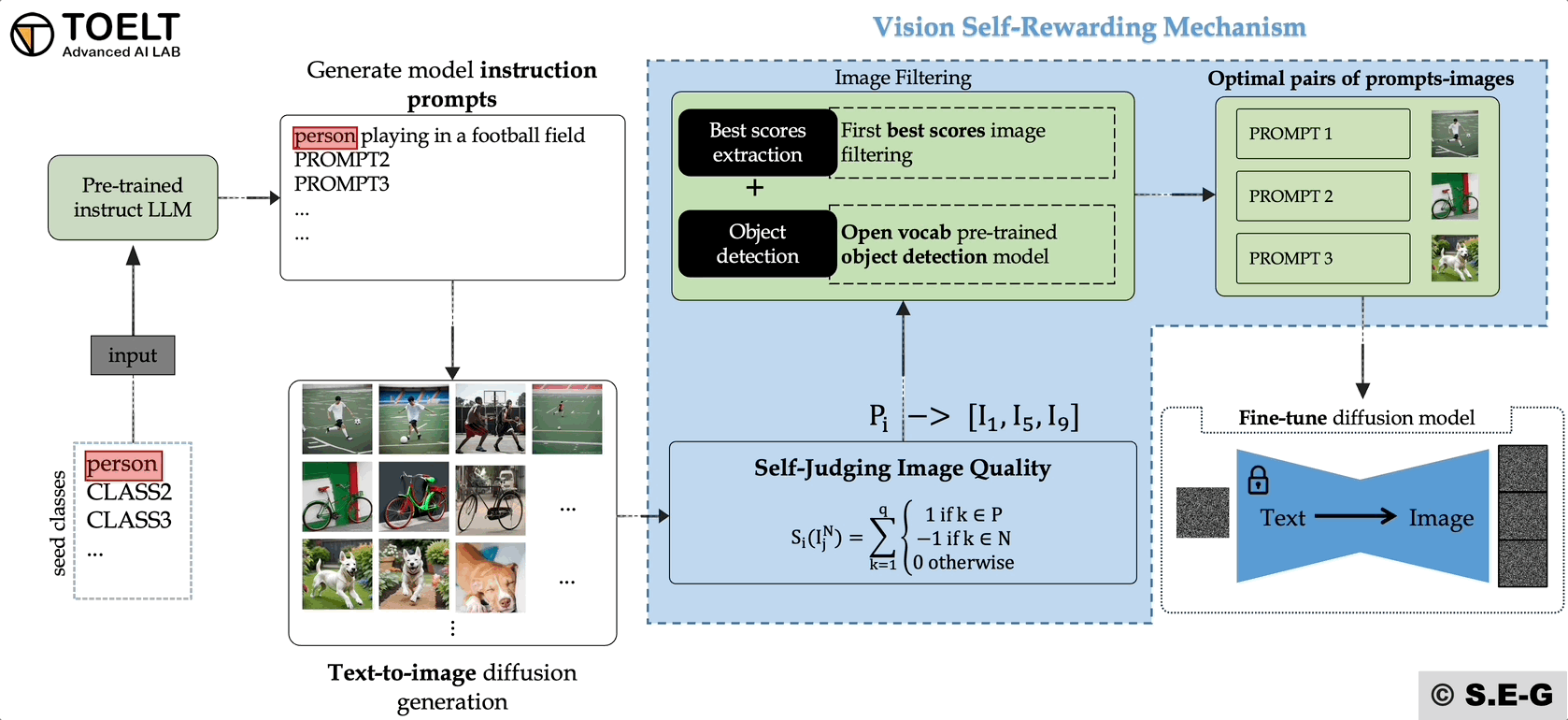This repository contain the official implement of the paper CCSR: Self-Rewarding Pretrained Text-to-Image Models.
Pre-print:
CCSR is a mechanism that allows diffusion models (T2I) to learn from their own generated images and continuously self-improve. This technique is inspire from this paper: Self-Rewarding Language Models.
The idea is similar but the method is different. An overall flowchart of the Self-rewarding mechanism is presented in the Gif bellow.
- Clone the repository and install dependencies using
git clone https://github.com/safouaneelg/SRT2I.git- Create a conda environment (optional but recommended) from environment.yml
conda env create -f environment.yml
conda activate srt2iStep-by-step self-rewarding
- First step is to generate the prompts for generative text-to-image diffusion model. This could be achieved using the following command:
python llm/prompts_generator.py --model "TheBloke/Mistral-7B-Instruct-v0.2-AWQ" --class_list "llm/class_list.json" --output_prompts "generated_prompts.txt" --prompts_number 30 --class_ids 15,16,17,20,21The default parameters are:
"TheBloke/Mistral-7B-Instruct-v0.2-AWQ"Mistral 7B quantizedllm/class_list.json(containing 80 classes from COCO datasets)generated_prompts.txtA total of 80*5=400 prompts are generated and stored in this file txt formatprompts_numberThe default number of prompts per class is 30 (for the paper we used 100).
Those are the class ids used in the paper: {20:Elephant} and {23:Giraffe}. In case you generate new prompts for other classes please change with the appropriate ids in class_list.
- The subsequent step is the generation of images from prompts, which can be done by using stable diffusion model. Run the following command to generate the images. The images are stacked by 10
python diff_generator/fromprompt_t2i_generation.py --diffusion-model "stabilityai/stable-diffusion-2-1-base" --output-folder "generative_images/" --prompts "generated_prompts.txt"The default parameters are:
"stabilityai/stable-diffusion-2-1-base"stable diffusion 2.1generative_images/folder to store the generated imagesgenerated_prompts.txtA total of 80*5=400 prompts are generated and stored in this file txt formatprompts_numberThe default number of prompts per class is 30
- To extract the optimal images based on the generated stable diffusion images. You can run the following command:
python sr_mechanism/self-reward_dataset_creation.py --image_folder 'path/to/images/folder/' --prompts_file 'path/to/prompts_file.txt' --llava_model 'LLAVA_MODEL' --yolo_model 'YOLO_WORLD_MODEL' 'yolov8x-worldv2.pt' --output_folder './optimal_pairs4/'Parsers:
- image_folder: path to the folder containing stacked 10 images (typically
generative_images/in this code) - prompt_file: path to the
.txtfile containing all the prompt (generated_prompts.txt) - llava_model: name of llava captioning model. Default set to
'llava-hf/llava-1.5-7b-hf' - yolo_model: Open Vocabulary YOLO model set by default to
'yolov8x-worldv2.pt'but can also be changed to'yolov8m-world.pt'or'yolov8s-world.pt'(check Ultralytics-docs) - llm_model: LLM model for self-judging set by default to
'TheBloke/Mistral-7B-Instruct-v0.2-AWQ' - output_folder:
'path/to/output/storage/folder/'where optimal images to specific prompts in the prompt_file in the will be saved
- Fine-tune stable diffusion on the images stored in the output_folder. To do so, follow these steps:
- The images folder requires an accompanying metada.json file (see hf docs)
- The steps and code demos (noteboks) are detailed in the txt2im readme
Once the dataset is ready and the training file customized, a single runs the script:
python tutorial/fine_tune_sd/fine_tune_lora4.shIn this example script, a single GPU is used to train for 100 epochs, using wandb for logging combined with validation prompts.
@misc{ghazouali2024classconditional,
title={Class-Conditional self-reward mechanism for improved Text-to-Image models},
author={Safouane El Ghazouali and Arnaud Gucciardi and Umberto Michelucci},
year={2024},
eprint={2405.13473},
archivePrefix={arXiv},
primaryClass={cs.CV},
url={https://arxiv.org/abs/2405.13473}
}
This code is open for research and development purposes only. No commercial use of this software is permitted. For additional information, contact: safouane.elghazouali@toelt.ai.

